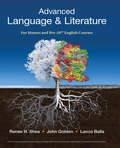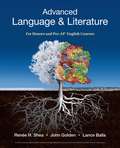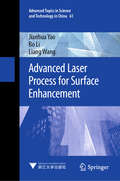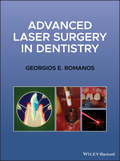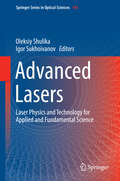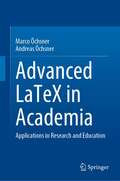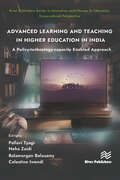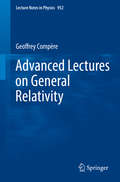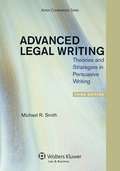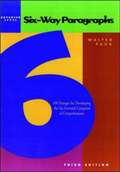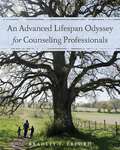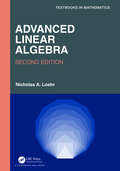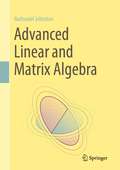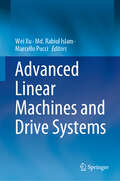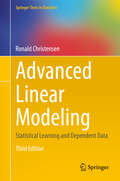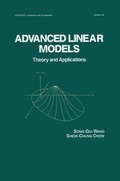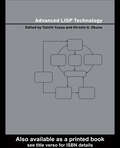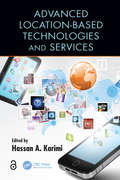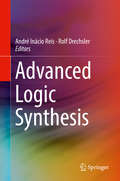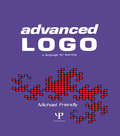- Table View
- List View
Advanced Language & Literature For Honors and Pre-AP® English Courses
by Shea Renee H.AP#65533; teachers know the roots of AP#65533; success are established in the earlier grades. That is the idea behind Advanced Language & Literature—a complete solution for 10th grade honors and Pre-AP#65533; English classes. Driven by the expertise of Renee Shea, John Golden, and Lance Balla, this introduction to literature and nonfiction, reading and writing, analysis and argument, is both challenging and nurturing; a book full of big ideas, thought-provoking texts, and all of the support young minds need to be prepared for AP#65533; success. *Pre-AP is a trademark registered and/or owned by the College Board, which was not involved in the production of and does not endorse this product.
Advanced Language & Literature for Honors and Pre-AP English Courses
by Renée H. Shea John Golden Lance BallaAP® teachers know the roots of AP® success are established in the earlier grades. That is the idea behind Advanced Language & Literature—a complete solution for 10th grade honors and Pre-AP® English classes. Driven by the expertise of Renee Shea, John Golden, and Lance Balla, this introduction to literature and nonfiction, reading and writing, analysis and argument, is both challenging and nurturing; a book full of big ideas, thought-provoking texts, and all of the support young minds need to be prepared for AP® success. *Pre-AP is a trademark registered and/or owned by the College Board, which was not involved in the production of and does not endorse this product.
Advanced Laser Process for Surface Enhancement (Advanced Topics in Science and Technology in China #61)
by Jianhua Yao Bo Li Liang WangTwo typical hybrid laser surface modification processes, i.e. electro/magnetic field aided laser process and supersonic laser deposition technology, are introduced in the book, to solve the common problems in quality control and low efficiency of the laser-only surface modification technology, high contamination and high consumption of the traditional surface modification technology. This book focuses on the principle, characteristics, special equipment, process and industrial applications of the hybrid laser surface modification processes based on the recent research results of the author’s group, and provides theoretical guidance and engineering reference for the researchers and engineers engaging in the field of surface engineering and manufacturing.
Advanced Laser Surgery in Dentistry
by Georgios E. RomanosAdvanced Laser Surgery in Dentistry delivers a state-of-the-art reference for laser technology in the context of a dental practice. The book encompasses oral surgery, periodontology, and implant dentistry, covering the latest research, knowledge, and clinical practices. The author demonstrates the clinical relevance by including many real-world clinical cases that illustrate the application of the discussed techniques. The book includes high-quality, color photographs throughout to support the text and add visual information to the covered topics, which include wound healing, oral surgery, periodontology, implant dentistry, and laser fundamentals and safety considerations. Advanced Laser Surgery in Dentistry provides readers with a step-by-step guide for using lasers in dental practice and discusses likely new directions and possible future treatments in the rapidly advancing field of laser dentistry. Readers will also benefit from a wide variety of subjects, including: A thorough introduction to the fundamentals of lasers, including the beam, the laser cavity, active mediums, lenses, resonators, and delivery systems An exploration of lasers and wound healing, including soft tissue and bone healing, as well as laser-assisted excisions and osteotomies An analysis of lasers in periodontology, including laser-assisted bacteria reduction in the periodontal tissues and the removal of subgingival dental calculus A discussion of lasers in implant dentistry and treatment for peri-implantitis Perfect for oral and maxillofacial surgeons, periodontists, and implant dentists, as well as general dentists, Advanced Laser Surgery in Dentistry will also earn a place in the libraries of dental students and residents seeking to improve their understanding of laser-based oral and dental procedures with a carefully organized reference guide.
Advanced Lasers: Laser Physics and Technology for Applied and Fundamental Science (Springer Series in Optical Sciences #193)
by Oleksiy Shulika Igor SukhoivanovPresenting a blend of applied and fundamental research in highly interdisciplinary subjects of rapidly developing areas, this book contains contributions on the frontiers and hot topics of laser physics, laser technology and laser engineering, and covers a wide range of laser topics, from all-optical signal processing and chaotic optical communication to production of superwicking surfaces, correction of extremely high-power beams, and generation of ultrabroadband spectra. It presents both review-type contributions and well researched and documented case studies, and is intended for graduate students, young scientist, and emeritus scientist working/studying in laser physics, optoelectronics, optics, photonics, and adjacent areas. The book contains both experimental and theoretical studies, as well as combinations of these two, which is known to be a most useful and interesting form of reporting scientific results, allowing students to really learn from each contribution. The book contains over 130 illustrations.
Advanced LaTeX in Academia: Applications in Research and Education
by Andreas Öchsner Marco ÖchsnerThis book contains a comprehensive treatment of advanced LaTeX features. The focus is on the development of high quality documents and presentations, by revealing powerful insights into the LaTeX language. The well-established advantages of the typesetting system LaTeX are the preparation and publication of platform-independent high-quality documents and automatic numbering and cross-referencing of illustrations or references. These can be extended beyond the typical applications, by creating highly dynamic electronic documents. This is commonly performed in connection with the portable document format (PDF), as well as other programming tools which allow the development of extremely flexible electronic documents.
Advanced Leadership Field Perspectives: Detroit
by Ai-Ling Jamila Malone Rosabeth Moss KanterIndustry and Background Note
Advanced Leadership Field Perspectives: Shanghai
by William C. Kirby Erica M ZendellIndustry and Background Note
Advanced Learning and Teaching in Higher Education in India: A Policy-technology-capacity Enabled Approach
by Pallavi Tyagi Neha Zaidi Balamurgan Balusamy Celestine IwendiThis book comprehensively covers the evolution of advanced learning pedagogy and innovative technologies like open educational resources and blended learning models. It specifically talks about the future of technology-enhanced learning and how advanced technology and government policies together are trying to impact learning outcomes globally. Nowadays in a flexible learning environment, technology plays a significant role in higher education systems. Both educators and students are playing prominent roles in its successful implementation. Advanced learning pedagogy by using technology has not only changed teaching procedures but has also evolved the relationship among multiple stakeholders.The content of the book is neatly segregated into four parts. Part I covers the concept and evolution of digital learning and education technology. This part examines the role of technology in higher education and proposes a toolkit for personalized learning and continuous assessment.Parts II and III creatively represent the innovative teaching techniques and learning models under advance learning pedagogy. Chapters under parts II and III are specially designed to present the more simplistic view of various technology-based advanced learning models and resources like flipped classes, gaming designs for e-learning, etc. Part III of the book also extensively covers various case studies/instructor’s stories of technology enabled learning experiences.Part IV focuses on the evaluation of advance learning pedagogy and tools. It also covers the future of information in learning (like formative analytics) and improved learning outcomes using technology and government initiatives in the form of various future oriented education policies like the Digital Action Education Plan (2021–2027).The wide-ranging content also covers the challenges of implementation of advanced learning pedagogy and offers recommendations to overcome such challenges. The book will grab the attention of the modern (IT-enabled) instructor’s fraternity, and students and researchers in the area of technology and education. The book can be further used by policymakers and educational-technology startups to formulate and design technology-based higher education teaching policies and procedures which are indeed helpful in measuring learning outcomes.
Advanced Lectures on General Relativity
by Geoffrey CompèreThese lecture notes are intended for starting PhD students in theoretical physics who have a working knowledge of General Relativity. The four topics covered are: Surface charges as conserved quantities in theories of gravity; Classical and holographic features of three-dimensional Einstein gravity; Asymptotically flat spacetimes in four dimensions: BMS group and memory effects; The Kerr black hole: properties at extremality and quasi-normal mode ringing. Each topic starts with historical foundations and points to a few modern research directions.
Advanced Legal Writing: Theories and Strategies in Persuasive Writing (Third Edition)
by Michael R. SmithWith a practical focus on persuasive writing strategy, Michael R. Smith identifies and explores three processes of persuasive writing--logos, pathos, and ethos--and provides a thorough introduction to the elements of rhetorical style. Using detailed how-to guides and plenty of examples, the author's distinctive approach to persuasive writing examines: technical aspects of rhetorical style: metaphor, literary allusion, figures of speech, and graphic design three basic processes of persuasive legal writing strategy: Logos: logic and rational argument Pathos: value-based argument Ethos: establishing credibility interdisciplinary contributions to persuasive writing from fields such as cognitive psychology, classical rhetoric, and morality theory effective strategies that extend beyond the trial or appellate brief to a broad range of documents and settings In the Second Edition, the reader will find: a new organization that puts a greater emphasis on practice and relatively less on theory for each of the three processes of persuasive writing strategy a new six-Part organization: I. Introduction II. Logos Strategies III. Pathos Strategies IV. Ethos Strategies V. Rhetorical Style VI. The Ethics and Morality of Persuasion coverage of new developments in cognitive psychology, Pathos persuasion, and the role of metaphor in persuasive legal writing. the same manageable length For a complete examination of the technique and strategy behind persuasive writing, Smith's text strikes the right balance of depth and scope for upper-level legal writing courses.
Advanced Level: Six-Way Paragraphs
by Walter PaukSix-Way Paragraphs, a three-level series, teaches the basic skills necessary for reading factual material through the use of the following six types of questions: subject matter, main idea, supporting details, conclusions, clarifying devices, and vocabulary in context.
An Advanced Lifespan Odyssey For Counseling Professionals
by Bradley ErfordWelcome to the lifespan odyssey! This text was designed to align with CACREP standards for counselor training programs. The background education and experiences of counselors in training are quite diverse: many have undergraduate degrees in psychology, education, or human services, while others have undergraduate degrees in business, the humanities, or some other discipline. Thus, some start with a basic understanding of human development and perhaps an undergraduate course on the topic, while others have no previous exposure to the content domain. The alignment with CACREP standards helps all counselors-in-training to master the core knowledge of lifespan development, but more importantly to apply this knowledge to helping people resolve difficulties they may encounter on their lifespan odysseys. These issues might include the implications of substance abuse for development, behavioral or emotional issues associated with trauma or an unstable environment, interventions that have been shown to be effective when working with clients along the spectrum of developmental problems, and the normal and abnormal human developmental processes that counselors must master and apply during clinical experiences--and when they take their rightful place as counseling professionals!
Advanced Linear Algebra (Textbooks in Mathematics)
by Bruce CoopersteinThis book discusses structure theory of an operator, topics on inner product spaces, and trace and determinant functions of a linear operator. It addresses bilinear forms with a full treatment of symplectic spaces and orthogonal spaces, as well as explains construction of tensor, symmetric, and exterior algebras. Featuring several new exercises, the second edition adds coverage of sesquilinear forms, linear groups, matrices, normed vector spaces, orthogonal spaces over perfect fields of characteristic two, and Clifford algebras. A solutions manual is available upon qualifying course adoption.
Advanced Linear Algebra (Textbooks in Mathematics)
by Nicholas A. LoehrDesigned for advanced undergraduate and beginning graduate students in linear or abstract algebra, Advanced Linear Algebra covers theoretical aspects of the subject, along with examples, computations, and proofs. It explores a variety of advanced topics in linear algebra that highlight the rich interconnections of the subject to geometry, algebra, analysis, combinatorics, numerical computation, and many other areas of mathematics.The author begins with chapters introducing basic notation for vector spaces, permutations, polynomials, and other algebraic structures. The following chapters are designed to be mostly independent of each other so that readers with different interests can jump directly to the topic they want. This is an unusual organization compared to many abstract algebra textbooks, which require readers to follow the order of chapters.Each chapter consists of a mathematical vignette devoted to the development of one specific topic. Some chapters look at introductory material from a sophisticated or abstract viewpoint, while others provide elementary expositions of more theoretical concepts. Several chapters offer unusual perspectives or novel treatments of standard results.A wide array of topics is included, ranging from concrete matrix theory (basic matrix computations, determinants, normal matrices, canonical forms, matrix factorizations, and numerical algorithms) to more abstract linear algebra (modules, Hilbert spaces, dual vector spaces, bilinear forms, principal ideal domains, universal mapping properties, and multilinear algebra).The book provides a bridge from elementary computational linear algebra to more advanced, abstract aspects of linear algebra needed in many areas of pure and applied mathematics.
Advanced Linear Algebra for Engineers with MATLAB
by Sohail A. Dianat Eli SaberArming readers with both theoretical and practical knowledge, Advanced Linear Algebra for Engineers with MATLAB® provides real-life problems that readers can use to model and solve engineering and scientific problems in fields ranging from signal processing and communications to electromagnetics and social and health sciences. Facilitating a unique understanding of rapidly evolving linear algebra and matrix methods, this book: Outlines the basic concepts and definitions behind matrices, matrix algebra, elementary matrix operations, and matrix partitions, describing their potential use in signal and image processing applications Introduces concepts of determinants, inverses, and their use in solving linear equations that result from electrical and mechanical-type systems Presents special matrices, linear vector spaces, and fundamental principles of orthogonality, using an appropriate blend of abstract and concrete examples and then discussing associated applications to enhance readers’ visualization of presented concepts Discusses linear operators, eigenvalues, and eigenvectors, and explores their use in matrix diagonalization and singular value decomposition Extends presented concepts to define matrix polynomials and compute functions using several well-known methods, such as Sylvester’s expansion and Cayley-Hamilton Introduces state space analysis and modeling techniques for discrete and continuous linear systems, and explores applications in control and electromechanical systems, to provide a complete solution for the state space equation Shows readers how to solve engineering problems using least square, weighted least square, and total least square techniques Offers a rich selection of exercises and MATLAB® assignments that build a platform to enhance readers’ understanding of the material Striking the appropriate balance between theory and real-life applications, this book provides both advanced students and professionals in the field with a valuable reference that they will continually consult.
Advanced Linear and Matrix Algebra
by Nathaniel JohnstonThis textbook emphasizes the interplay between algebra and geometry to motivate the study of advanced linear algebra techniques. Matrices and linear transformations are presented as two sides of the same coin, with their connection motivating inquiry throughout the book. Building on a first course in linear algebra, this book offers readers a deeper understanding of abstract structures, matrix decompositions, multilinearity, and tensors. Concepts draw on concrete examples throughout, offering accessible pathways to advanced techniques. Beginning with a study of vector spaces that includes coordinates, isomorphisms, orthogonality, and projections, the book goes on to focus on matrix decompositions. Numerous decompositions are explored, including the Shur, spectral, singular value, and Jordan decompositions. In each case, the author ties the new technique back to familiar ones, to create a coherent set of tools. Tensors and multilinearity complete the book, with a study of the Kronecker product, multilinear transformations, and tensor products. Throughout, “Extra Topic” sections augment the core content with a wide range of ideas and applications, from the QR and Cholesky decompositions, to matrix-valued linear maps and semidefinite programming. Exercises of all levels accompany each section. Advanced Linear and Matrix Algebra offers students of mathematics, data analysis, and beyond the essential tools and concepts needed for further study. The engaging color presentation and frequent marginal notes showcase the author’s visual approach. A first course in proof-based linear algebra is assumed. An ideal preparation can be found in the author’s companion volume, Introduction to Linear and Matrix Algebra.
Advanced Linear Machines and Drive Systems
by Wei Xu Md. Rabiul Islam Marcello PucciThis book collects the latest theoretical and technological concepts in the design and control of various linear machines and drive systems. Discussing advances in the new linear machine topologies, integrated modeling, multi-objective optimization techniques, and high-performance control strategies, it focuses on emerging applications of linear machines in transportation and energy systems. The book presents both theoretical and practical/experimental results, providing a consistent compilation of fundamental theories, a compendium of current research and development activities as well as new directions to overcome critical limitations.
Advanced Linear Modeling: Statistical Learning and Dependent Data (Springer Texts in Statistics)
by Ronald ChristensenThis book introduces several topics related to linear model theory, including: multivariate linear models, discriminant analysis, principal components, factor analysis, time series in both the frequency and time domains, and spatial data analysis. This second edition adds new material on nonparametric regression, response surface maximization, and longitudinal models. The book provides a unified approach to these disparate subjects and serves as a self-contained companion volume to the author's Plane Answers to Complex Questions: The Theory of Linear Models. Ronald Christensen is Professor of Statistics at the University of New Mexico. He is well known for his work on the theory and application of linear models having linear structure.
Advanced Linear Models: Theory and Applications (Statistics: Textbooks and Monographs #141)
by Shein-Chung Chow Song-Gui WangThis work details the statistical inference of linear models including parameter estimation, hypothesis testing, confidence intervals, and prediction. The authors discuss the application of statistical theories and methodologies to various linear models such as the linear regression model, the analysis of variance model, the analysis of covariance model, and the variance components model.
Advanced LISP Technology
by Taiichi Yuasa Hiroshi G. OkunoDevelopments in Lisp technology have been accelerated by a number of factors, including the increased interest in Artificial Intelligence and the emergence of Common Lisp. Advanced Lisp Technology, the fourth volume in the Advanced Information Processing Technology series, brings together various Japanese researchers working in the field of Lisp te
Advanced Location-Based Technologies and Services
by Hassan A. KarimiSince the publication of the first edition in 2004, advances in mobile devices, positioning sensors, WiFi fingerprinting, and wireless communications, among others, have paved the way for developing new and advanced location-based services (LBSs). This second edition provides up-to-date information on LBSs, including WiFi fingerprinting, mobile computing, geospatial clouds, geospatial data mining, location privacy, and location-based social networking. It also includes new chapters on application areas such as LBSs for public health, indoor navigation, and advertising. In addition, the chapter on remote sensing has been revised to address advancements.
Advanced Logic Synthesis
by Rolf Drechsler André Inácio ReisThis book provides a single-source reference to the state-of-the-art in logic synthesis. Readers will benefit from the authors' expert perspectives on new technologies and logic synthesis, new data structures, big data and logic synthesis, and convergent logic synthesis. The authors describe techniques that will enable readers to take advantage of recent advances in big data techniques and frameworks in order to have better logic synthesis algorithms.
Advanced Logo: A Language for Learning (Computer Science for the Behavioral Sciences Series)
by Michael FriendlyAdvanced Logo shows how LOGO can be used as a vehicle to promote problem solving skills among secondary students, college students, and instructors. The book demonstrates the wide range of educational domains that can be explored through LOGO including generative grammars, physical laws of motion and mechanics, artificial intelligence, robotics, and calculus.
